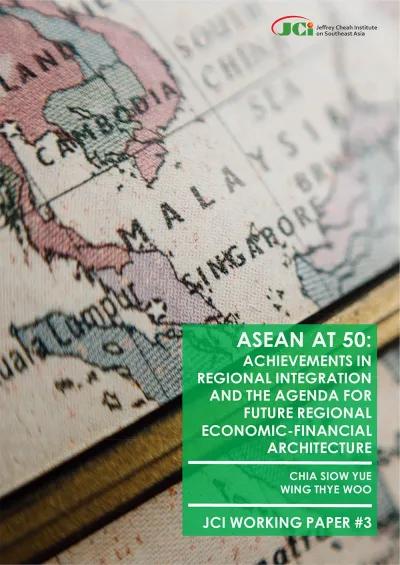
JCI-WP-2018-03: ASEAN at 50: Achievements in Regional Integration and the Agenda for Future Regional Economic-Financial Architecture
Publication date: July 2019 (2nd edition) | Length of paper: 36 pages | ISBN: 978-967-5492-14-3
Despite large differences on almost every dimension, ASEAN can claim to be one of the most successful regional groupings in the world. ASEAN has largely achieved regional peace and security, despite being caught in the US-China power rivalry in recent years. The ASEAN region has also become one of the largest economies in the world, with a combined GDP that ranks behind only the EU, US, China, Japan, India and South Korea and growth rates well above the world average. ASEAN economic integration has proceeded simultaneously via market-driven regional production networks and global value chains as well as via government-driven trade and investment agreements. The objective of creating an ASEAN Economic Community (AEC) was adopted in 2015; and the next phase of integration, AEC 2025, is under implementation. ASEAN has also entered into regional integration agreements (known as ASEAN+1) with China, Japan, India, South Korea, Australia, and New Zealand, and is in the process of negotiating a mega Regional Comprehensive Economic Partnership (RCEP) agreement with these six partners.
One often-mentioned vision about the future of the financial architecture of ASEAN –that was popular in the period after the Asian Financial Crisis — was an Asian Economic Union (AEU), where there was comprehensive, deep regional economic integration. The basic question is whether the final realized form of the Asian Economic Union (AEU) would be closer to the European Union (EU) or to the North America Free Trade Area (NAFTA). The return of China as a major global economic power also means that the Renminbi (RMB) could, in the future, attain an international status that is parallel to the USD. The emergence of the RMB as a key international currency, however, does not in any way imply that it would also emerge to be the common currency for East Asia. China in the future would most probably have the same individualistic attitude on China’s monetary policy as the United States has at the present toward other countries that have dollarised their economies, which is that the primary concern of US monetary policy is US welfare. Given (1) the NAFTA-like disparity in economic power in AEU in the future, and (2) the absence of policy-induced integration of national labor markets mean that the only stable configuration is the survival of individual East Asian currencies with limited coordination among them in normal times. It therefore appears to us that the many present efforts to promote closer exchange rate cooperation will not succeed in the long-run.
References
Test references
Download
Download
Author(s)
Chia Siow Yue
The JCI-JSC Working Paper series is published to disseminate preliminary research findings and stimulate intellectual discourse on wide-ranging public policy issues, ranging from security to sustainability. The views expressed herein are those of the author(s) and do not necessarily reflect the views of the Jeffrey Cheah Institute on Southeast Asia and the Jeffrey Sachs Center on Sustainable Development.



